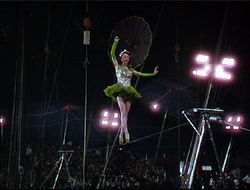Difference between revisions of "Main Page"
From Circopedia
| Line 28: | Line 28: | ||
==In The Spotlight== | ==In The Spotlight== | ||
[[File:Lola_Dobritch_GSOE.jpg|right|250px]] | [[File:Lola_Dobritch_GSOE.jpg|right|250px]] | ||
| − | === | + | ===UNUS=== |
| − | + | Unus (1907-1994) was perhaps, in the mid-twentieth century, the most famous hand balancer in the circus business, thanks notably to John Ringling North, who made him a true circus star in the United States and, consequently, all over Europe. Unus was known as "The man who stands on his forefinger," a feat he performed with outstanding and—to this day—unmatched showmanship. | |
| − | + | He was born Franz Furtner on October 19, 1907 in Eichgraben, a small town in the northeast of Austria. Franz didn’t belong to a circus family: He began his professional life as a carpenter. Yet over the years, he had developed a taste for acrobatics, and notably hand balancing, and he had a natural flair for performing. Soon, he realized that he could make a living just doing that. | |
| + | |||
| + | So Franz built a hand balancing act, and under the stage name Unus (a Latin word that means "one" or "single"—and by extension, "the first" or "the only one") made his professional debut in 1933, at age twenty-six. From the outset, he worked mostly in variete theaters, then extremely popular in Germany and Austria; this theatrical environment helped define the look of his act—a characteristic of which was an emphasis on urbanity and elegance.... ([[Unus|more...]]) | ||
==New Biographies== | ==New Biographies== | ||
Revision as of 21:31, 1 May 2014
|
In The Spotlight
UNUS
Unus (1907-1994) was perhaps, in the mid-twentieth century, the most famous hand balancer in the circus business, thanks notably to John Ringling North, who made him a true circus star in the United States and, consequently, all over Europe. Unus was known as "The man who stands on his forefinger," a feat he performed with outstanding and—to this day—unmatched showmanship.
He was born Franz Furtner on October 19, 1907 in Eichgraben, a small town in the northeast of Austria. Franz didn’t belong to a circus family: He began his professional life as a carpenter. Yet over the years, he had developed a taste for acrobatics, and notably hand balancing, and he had a natural flair for performing. Soon, he realized that he could make a living just doing that.
So Franz built a hand balancing act, and under the stage name Unus (a Latin word that means "one" or "single"—and by extension, "the first" or "the only one") made his professional debut in 1933, at age twenty-six. From the outset, he worked mostly in variete theaters, then extremely popular in Germany and Austria; this theatrical environment helped define the look of his act—a characteristic of which was an emphasis on urbanity and elegance.... (more...)
New Biographies
- Unus, Hand Balancer
- Die Maiers, Comedy Aerialists
- The Dobrich Family (History)
- Uuve Jansson, Aerialist
- Pieric, Clown, Equestrian
New Videos
- Jorgen & Conny, Hand-to-Hand and Perch-Pole Balancing (1965)
- The Flying Neves, Flying Trapeze (2011)
- The Rudi-Llata, Clowns (1957)
- Unus, Hand Balancing Act (1956)
- Rogana, Sword balancing Act (c.1970)
Featured Oral Histories
- Nikolai Pavlenko, tiger trainer - Interview (RIA Novosti, 2012)
- Alberto Zoppé, Equestrian - Interview (McCutcheon & Distasio, 2003)
- Olivier Taquin, Mime - Interview (Jando, 2008)
- Barry Lubin, Clown (Grandma) - Interview (Jando, 2008)
- Fumagalli, Clown - Interview (Jando, 2008)
A Message from the Editor
CIRCOPEDIA is a constantly evolving and expanding encyclopedia of the international circus. New videos, biographies, essays, and documents are added to the site on a weekly—and sometimes daily—basis. So keep visiting us: even if today you don't find what you're looking for, it may well be here tomorrow! And if you are a serious circus scholar and spot a factual or historical inaccuracy, do not hesitate to contact us: we will definitely consider your remarks and suggestions.
- Dominique Jando
- Editor/Curator
